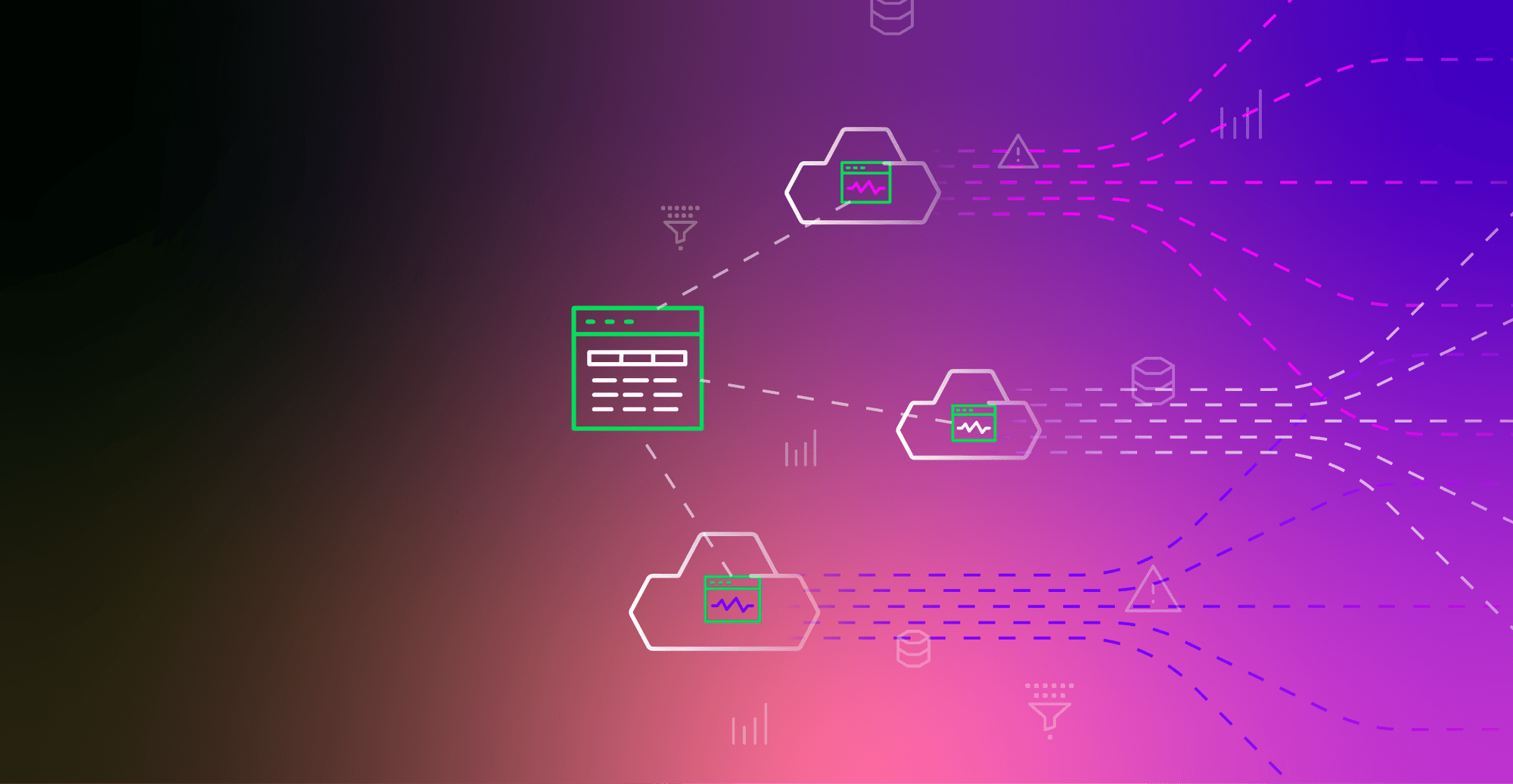Managing large datasets in data analysis and monitoring is challenging. Fortunately, two essential techniques can simplify this task: Downsampling and Aggregating Metrics.
Downsampling reduces time-series data resolution by summarizing several data points into single values over specified intervals. It retains critical trends and patterns while decreasing data volume, which makes it more manageable.
In contrast, aggregating metrics combines multiple data points into summary statistics like averages, sums, or percentiles. It provides concise summaries, highlights key performance indicators and trends, and enhances data clarity and interpretability.
When combined, downsampling and aggregating metrics simplify data processing, reduce storage, and turn complexity into actionable insights. However, implementing these two also introducted challenges that you must understand.
This article discusses the advantages and disadvantages of downsampling and aggregating metrics and how they impact data monitoring and analysis.
Key Takeaways
- Downsampling and aggregating metrics reduce massive data storage and processing. The former reduces data points to decrease storage. Meanwhile, the latter summarizes data using sums, averages, and counts.
- One of the primary disadvantages of downsampling and aggregating metrics is the risk of losing fine-grained data necessary for analysis.
- While useful for high-level overviews, aggregating metrics can oversimplify and misinterpret complex data.
- To balance the pros and cons of downsampling and aggregating metrics, choose metrics carefully, sample intelligently, and monitor strategies. It’s also crucial to balance granularity and performance to ensure effective downsampling.
What are Downsampling and Aggregating Metrics?
In data engineering, downsampling and aggregating metrics are crucial for efficiently managing and analyzing large datasets.
Downsampling
Downsampling refers to reducing the volume of data points by sampling at lower frequencies. This systematic selection of a data subset at a lower rate helps reduce the following:
- Computational requirements
- Storage needs
- Potential noise
For instance, consider time series data where server performance metrics like CPU usage are logged every second. This logging can quickly result in an overwhelming amount of data. By downsampling to record CPU usage every minute instead, the dataset becomes smaller and more manageable, facilitating more accessible analysis and visualization.
Aggregation
Aggregating metrics, on the other hand, involves summarizing data points to derive meaningful statistics. This process gathers and expresses data in a summary form, making it possible to analyze large datasets quickly and efficiently.
For example, a company might aggregate customer data to determine the average age of customers for different products. Instead of analyzing each customer individually, the company can summarize the data to show the average age per product. This approach provides valuable insights into customer demographics without processing the entire dataset in its raw form.
Note
Both downsampling and aggregating metrics are essential in various fields, such as business analytics, healthcare, and finance. By reducing data volume and summarizing data points, IT teams can implement effective data processing, which improves decision-making and strategic planning.
Pros of Downsampling and Aggregating Metrics
When used in combination, downsampling and aggregating metrics reduce storage and processing needs for massive data sets. These techniques enhance performance, streamline monitoring, and maintain essential insights without compromising data quality.
Here are some of the advantages of downsampling and aggregating metrics.
Improved Data Manageability
Downsampling and aggregating metrics reduce data size while preserving essential information. As a result, these processes make data more manageable for better analytical performance. They also preserve essential data by selecting fewer points or summarizing several data points.
Since downsampling condenses data, storage requirements are also significantly decreased. For instance, the size of downsampled indices is only a fraction of the raw metrics indices.
Aggregating metrics summarize the operations on raw data. These metrics provide a high-level overview, enabling quick insights and trend analysis. By using pre-aggregated metrics, the system avoids calculating results on the fly, cutting the computational load and speeding up data retrieval.
Enhanced Performance and Efficiency
Downsampling and aggregating metrics enhance system performance and efficiency by reducing processing and storage needs.
With downsampling, you can lower the resolution of time-series data by averaging, summarizing, or taking minimum or maximum values over a set interval. Smaller datasets can improve query and analysis performance, lowering computational overhead.
Aggregation summarizes detailed data using statistical measures like sums, averages, or counts. It reduces the operations needed to generate insights, leading to faster data processing and decision-making. It also helps detect trends and patterns without sifting through excessive details.
When combined, downsampling and aggregation save storage space, accelerate queries and analyses and reduce system strain. As a result, the two processes significantly lower operational costs.
Simplified Data Analysis
Downsampling and aggregating metrics simplify data analysis by condensing large datasets into digestible summaries that show trends and patterns. These techniques provide a concise overview of data trends, making interpreting and deriving insights easier.
Analysts can quickly comprehend the key points by giving a clear overview rather than a detailed explanation of the raw data. They can derive meaningful insights more effectively when they have a clear overview.
Cost Savings
By downsampling and aggregating metrics, you can control cloud storage costs by preserving recent data in raw format and historical data at a lower resolution. This approach reduces high-resolution data for storage, minimizing space and costs.
These two processes also reduce cloud costs by:
- Reducing datasets for smaller storage: Smaller datasets need less storage space, directly reducing the costs associated with data storage solutions.
- Improving query performance: Processing smaller datasets consumes less computational power, lowering operational costs and energy consumption.
- Optimizing data retention policies: Efficient data management ensures that only necessary data is stored at high resolution, further controlling storage costs.
Cons of Downsampling and Aggregating Metrics
While downsampling and aggregating metrics help streamline massive datasets and reduce storage costs, they come with challenges. Reducing data granularity can obscure critical insights, delay anomaly detection, and miss rare events, which can affect monitoring system accuracy and responsiveness.
Learn more about the cons of downsampling and aggregating metrics below.
Loss of Detail and Granularity
Downsampling and aggregating metrics can potentially lead to the loss of fine-grained details crucial for specific analyses. Due to the combined statistics or reduced data resolution, these methods can hide significant irregularities, which can make issues and trends more challenging to identify.
This loss of detail in business contexts can lead to oversimplified conclusions that fail to capture complex market dynamics or consumer behaviors. Aggregated data might show stable trends, but it can miss sudden spikes in demand or brief periods of downtime, resulting in missed opportunities in market conditions.
Note
Fine-grained data can reveal intricate details about system behavior, such as micro-spikes in latency, intermittent errors, and subtle performance degradations. These details help detect potential issues, allowing for proactive intervention before minor problems escalate into significant outages.
Potential for Misinterpretation
Aggregating metrics can also lead to significant misinterpretations by oversimplifying complex data. This error occurs when the aggregation process reduces detailed information to summarize statistics, which, in turn, can mask significant variations and anomalies.
The aggregated data may present an oversimplified view that doesn’t accurately reflect the underlying reality. Averages can be misleading, suggesting moderate performance while hiding extremes where many users face poor performance. As a result, decision-makers might make strategies without considering the variation within groups.
Delayed Detection of Anomalies
Downsampling and aggregating metrics can delay the detection of anomalies and rare events by reducing the granularity and frequency of data points. This downside can smooth out or entirely miss minor but critical deviations from the norm and delay response times.
For this reason, rare events might become invisible in the aggregated data due to average outs and masking by more frequent data points. Further, advanced anomaly detection algorithms require high-frequency, detailed data to distinguish between normal variations and true anomalies. By using reduced data points, you can compromise these algorithms’ performance, affecting timely and accurate anomaly detection.
Reduced Accuracy in Analysis
Aggregation and downsampling can lead to incomplete data representation, impacting the accuracy of analyses and subsequent decision-making. Important nuances and fluctuations are lost when data points are averaged or reduced, which might be crucial for understanding the full context. This incomplete picture can lead to misguided conclusions and strategies since simplified data cannot accurately reflect real-world conditions.
Balancing the Pros and Cons of Downsampling & Aggregating Metrics
Understanding the balance is the key to implementing downsampling and metric aggregation. By doing so, you can maintain data integrity and value while optimizing performance. This practice involves carefully selecting which metrics to downsample, using intelligent sampling, and monitoring ongoing performance to adjust strategies.
Read on to learn strategies and best practices to balance the pros and cons of downsampling and aggregating metrics.
Strategies for Effective Downsampling
Finding the right balance between granularity and performance is vital to effective downsampling. While high granularity provides detailed information, it can lead to performance issues. Conversely, too much downsampling can obscure important details.
When downsampling, it’s essential to apply strategic guidelines to mitigate the drawbacks and maximize the benefits. Here’s how to effectively determine when and how to downsample to achieve the best results:
1. Identify Critical Metrics
Focus on identifying which metrics are crucial for your analysis and which can tolerate downsampling. Critical metrics that require high precision for anomaly detection or performance monitoring should be downsampled less aggressively.
2. Use Intelligent Sampling Techniques
Employ advanced sampling techniques that maintain the integrity of the data while reducing its volume. Stratified, systematic, or reservoir sampling can help preserve essential data characteristics.
Pro Tip: Apply stratified sampling to ensure all significant segments of your data are represented. You can also use systematic sampling for large, evenly distributed datasets.
3. Apply Variable Downsampling Rates
Adjust the downsampling rate dynamically based on the metric’s behavior and importance. For instance, higher sampling rates should be used during peak times or anomalies and lower during stable periods.
Implement adaptive sampling algorithms that adjust the rate based on real-time data patterns. Increase sampling rates during known periods of high variability or importance.
4. Preserve Anomaly Detection
Ensure that your downsampling method retains the ability to detect anomalies effectively. This ability might involve sketching or quantile sketches to summarize data distributions efficiently.
5. Balance Between Aggregation and Raw Data
While downsampling, maintain a balance between aggregated metrics and raw data points. This approach helps in detailed root cause analysis when required.
6. Implement Proper Time Window Management
Define appropriate time windows for downsampling. Shorter windows need higher fidelity, whereas longer historical data can be more aggressively downsampled.
7. Monitor Downsampling Impact
Review the impact of downsampling on your metrics regularly and adjust your strategy accordingly. Ensure that the loss of detail does not affect decision-making or operational efficiency.
Once you’ve implemented a downsampling strategy, monitoring its effectiveness is essential. Monitoring metrics like query performance and data storage size will help you adjust your strategy to ensure it continues to meet your system’s needs.
Downsampling is particularly useful when:
- Data storage costs become expensive
- Performance optimization is needed to improve query performance and reduce latency
- When analyzing long-term trends where fine granularity is less critical
Best Practices for Aggregating Metrics
Aggregating metrics effectively is crucial for maintaining system performance, ensuring accurate monitoring, and making informed decisions. Here are some best practices for aggregating metrics:
1. Define Clear Objectives
Clearly define what you want to achieve with your metrics aggregation. Clear objectives help determine essential metrics and how they should be aggregated. Determine the level of granularity needed. Too granular data can overwhelm, while too coarse data can miss critical insights.
2. Use Data Downsampling Wisely
Implement retention policies that downsample older data to save storage while keeping recent data more granular for immediate analysis. Use averaging, median calculation, or percentile extraction techniques to reduce data size without losing significant trends.
3. Ensure Data Consistency and Accuracy
Ensure all your systems have synchronized clocks to maintain the accuracy of time-series data. Use consistent labels and tags for metrics across different systems to avoid confusion and ensure accurate aggregation.
4. Monitor Aggregation Impact
Monitor the impact of your aggregation strategies on alerting and anomaly detection to ensure critical events are noticed. Regularly audit your aggregation methods and policies to ensure they align with your objectives and the current system’s needs.
5. Use Specialized Tools and Platforms
Utilize observability platforms that offer advanced features for aggregating and visualizing metrics. For specific needs, consider writing custom aggregation scripts that tailor the aggregation process to your unique requirements.
6. Balance Performance and Detail
Ensure that your aggregation process does not introduce significant latency or overhead, which could impact system performance. Strive to preserve enough detail in your aggregated data to make it meaningful and actionable.
Use Cases and Examples
Organizations can maintain actionable insights while avoiding data overload by reducing the frequency of data collection and summarizing similar metrics. Below is an example of successfully implementing these techniques, illustrating how they balance detail and manageability.
Case: Downsampling and Aggregating E-commerce Metrics for Black Friday Sale
During Black Friday, eCommerce platforms encounter a surge in user activity, generating millions of interactions per minute. This high data volume needs efficient management to ensure optimal system performance and provide actionable insights for sales strategies.
With downsampling and aggregation, these platforms can address data overload challenges during the surge.
For instance, you can implement one-minute intervals to calculate average CPU usage and 95th-percentile response time. This approach reduces data volume but still maintains enough to detect performance issues. Moreover, it will enable faster data processing and analysis.
Besides downsampling, aggregating sales metrics is crucial for managing the influx of user interactions.
For example, logging every user action, including product views, clicks, and purchases, can lead to excessive data. The platform can derive actionable insights by summarizing this data into hourly metrics without overwhelming the system. This approach helps optimize ongoing marketing campaigns and manage inventory more effectively.
Looking ahead
Downsampling and aggregating metrics help manage large datasets by reducing their volume. With less data to manage, you can enhance system performance and simplify data analysis. These techniques also improve data manageability and processing speed, saving costs.
While these two processes help, they can also lead to data oversimplification. This issue can mask critical details that delay anomaly detection and misinterpret risks.
The key to downsampling and aggregating metrics is to balance their benefits and drawbacks. This practice involves careful metric selection, intelligent sampling, and ongoing strategy adjustments.
FAQs on Downsampling & Aggregating Metrics
What are the disadvantages of downsampling?
Downsampling can result in losing crucial data from the majority class, compromising accuracy. Moreover, removing too many data points makes datasets too small for model training. Improper downsampling also introduces bias. If the retained sample points inaccurately represent the entire dataset, it reduces classifier performance.
What is the difference between downsampling and aggregation?
Downsampling reduces the resolution of time-series data by combining multiple points into one. Meanwhile, aggregation combines various data points to create a single summary value.
What is downsampling in metrics?
Downsampling in metrics reduces the resolution of metric data points over time. This technique cuts the storage and processing of high-frequency data by keeping fewer data points at a lower resolution.
Sources:
- Last9
- IBM
- Questdb
- Chronosphere
- Dagster.io
- Elastic
- TechTarget
- Microsoft
- Statistics
- StatisticsbyJim
- Klipfolio
- Oboloo






